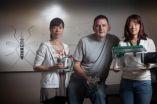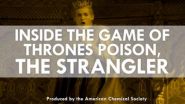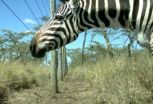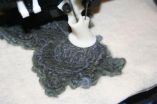(Press-News.org) The Department of Defense needs materials for armor windows that provide essential protection for both personnel and equipment while still having a high degree of transparency. To meet that need, scientists at the Naval Research Laboratory (NRL) have developed a method to fabricate nanocrystalline spinel that is 50% harder than the current spinel armor materials used in military vehicles. With the highest reported hardness for spinel, NRL's nanocrystalline spinel demonstrates that the hardness of transparent ceramics can be increased simply by reducing the grain size to 28 nanometers. This harder spinel offers the potential for better armor windows in military vehicles, which would give personnel and equipment, such as sensors, improved protection, along with other benefits. This research was reported in the January 30, 2014, issue of the journal Acta Materialia.
To create the harder spinel, the NRL research team sinters, or consolidates, commercial nanopowders into fully dense nanocrystalline materials. Sintering is a common method used to create large ceramic and metal components from powders. However, the NRL team is the first to succeed in making this harder spinel through their development of the Enhanced High Pressure Sintering (EHPS) approach, explains Dr. James Wollmershauser, a lead investigator in the research. The EHPS approach uses high pressures (up to 6 GPa) to retard bulk diffusion rates, break powder agglomerates, and reposition nanoparticles very close to each other to help eliminate porosity in the sintered ceramic. NRL researchers then can exploit the increased surface potential of nanoparticles for surface-energy-driven densification without coarsening.
Using this EHPS approach to create the nanocrystalline spinel, the NRL research team did not observe any decline in density or fracture resistance due to residual porosity. Other researchers have tried to make nanocrystalline spinel, but they have all had problems with the final product, such as, a reduced density, reduced fracture resistance, or reduced transparency. The reduced density in other researchers work is caused by voids that cannot be removed during processing, which can reduce hardness, fracture resistance and transparency. NRL's Wollmershauser notes that some theories suggest that fracture resistance should decrease when you make a ceramic material nanocrystalline. However, in their work, the NRL researchers have shown that the fracture resistance does not change suggesting that nanocrystalline ceramics can have an equivalent toughness to microcrystalline ceramics, which is important for high window lifetimes.
The Hall-Petch relationship has been used to describe the phenomenon where a material's strength and hardness can be increased by decreasing the average crystallite grain size. However, prior experimental work had shown a breakdown in this relationship (where hardness starts reducing with decreasing grain size) for certain ceramics at ~130 nanometers. Remarkably, the NRL researchers have disproved that a breakdown in the Hall-Perch effect exists at these nanoscale grain sizes by measuring an increasing hardness down to at least a 28 nanometer crystallite grain size. The new, high hardness values were measured on samples with these extremely small average grain sizes.
In current applications, spinel and sapphire (which is also very hard), are used to create materials for military armor windows. A drawback with sapphire is that it is expensive to make into windows. By increasing the hardness of spinel even further, NRL researchers can make a material harder than sapphire and possibly replace sapphire windows with windows made out of nanocrystalline spinel. Also, harder nanocrystalline spinel windows can be made thinner and still meet the current military specifications. This thinness translates to weight savings on the vehicle. So the NRL-developed nanocrystalline spinel brings improvements in hardness, window thickness and weight, and cost.
A final benefit is that the NRL-developed nanocrystalline spinel is highly transparent, making it useful in UV, visible and infrared optics. The armor material used by the military needs to be transparent so that both equipment and personnel can see. Different sensors "see" different wavelengths of light. Infrared is important for heat-seeking capabilities. UV imaging can be used to detect threats not seen in the visible spectrum. UV detectors also have applications in space-borne astronomy missions. A single window that could be produced using the NRL-developed nanocrystalline spinel would be transparent across many technologically important wavelengths, easing design and weight requirements.
Beyond the use for a harder spinel in armor windows, there could be other potential DoD and civilian applications in better/stronger office windows, smartphones and tablets screens, military/civilian vehicles, space vehicles, and even extraterrestrial rovers.
This research is a cross-disciplinary effort at Naval Research Laboratory. The NRL team includes Dr. James Wollmershauser, Dr. Edward Gorzkowski, Dr. Ramasis Goswami, Dr. Syed Qadri, and Dr. Richard Everett, from NRL's Materials Science and Technology Division; along with Dr. Boris Feigelson, Dr. Chase Ellis, Dr. Joseph Tischler, and Dr. Fritz Kub from NRL's Electronics Science and Technology Division.
INFORMATION:
The Naval Research Laboratory (NRL) is the Navy's full-spectrum corporate laboratory, conducting a broadly based multidisciplinary program of scientific research and advanced technological development. The Laboratory, with a total complement of more than 2800 personnel, is located in southwest Washington, DC, with other major sites at the Stennis Space Center, MS, and Monterey, CA. NRL has served the Navy and the nation for over 90 years and continues to meet the complex technological challenges of today's world. For more information, visit the NRL homepage or join the conversation on Twitter, Facebook, and YouTube.
NRL researchers develop harder ceramic for armor windows
2014-04-29
ELSE PRESS RELEASES FROM THIS DATE:
Saving crops and people with bug sensors
2014-04-29
RIVERSIDE, Calif. (http://www.ucr.edu) — University of California, Riverside researchers have created a method that can classify different species of insects with up to 99 percent accuracy, a development that could help farmers protect their crops from insect damage and limit the spread of insect-borne diseases, such as malaria and Dengue fever.
Over the past 60 years, insect classification research has been limited by factors including an overreliance on acoustic sensing devices, a heavy focus on wingbeat frequency and limited data.
The UC Riverside researchers overcame ...
The Strangler: The chemistry behind the Game of Thrones poison (video)
2014-04-29
WASHINGTON, April 28, 2014 — Game of Thrones gave us a shock with the Purple Wedding and now everyone is asking: "Who poisoned King Joffrey?" While the search for the killer continues, the American Chemical Society's latest Reactions video focuses on what killed the hated king. The video is available at http://youtu.be/6UNEpRXcxM4
Chemist Raychelle Burks, Ph.D., of Doane College helps us narrow down the suspects in her charismatic style, blending pop culture and chemistry. "Sometimes science gets a bad rap. People think it's dry or super serious," Burks says. "Pop culture ...
Information technology can simplify weight-loss efforts; social support still important for success
2014-04-29
COLUMBIA, Mo. – According to the Centers for Disease Control and Prevention (CDC), 69 percent of adults in the United States are currently overweight or obese, which puts these individuals at increased risk for chronic health problems. Although weight loss decreases this risk, statistics show that dieters often fail multiple times before meeting their goals. Now, MU researchers have found that information technology, such as smartphone applications, can help dieters integrate healthy behavior changes into their daily lives.
"Current weight loss recommendations are essentially ...
Immunogenic mutations in tumor genomes correlate with increased patient survival
2014-04-29
April 29, 2014 – Developing immunotherapies for cancer is challenging because of significant variability among tumors and diversity in human immune types. In a study published online today in Genome Research, researchers examined the largest collection of tumor samples to date to predict patient-specific tumor mutations that may activate the patient's immune system, paving the way for more successful, personalized cancer immunotherapy.
Tumor cells accrue mutations in their DNA, and as these mutations accumulate, the cell looks less and less like part of the body and more ...
Vitamin D may raise survival rates among cancer patients
2014-04-29
Washington, DC—Cancer patients who have higher levels of vitamin D when they are diagnosed tend to have better survival rates and remain in remission longer than patients who are vitamin D-deficient, according to a new study published in the Endocrine Society's Journal of Clinical Endocrinology & Metabolism (JCEM).
The body naturally produces vitamin D after exposure to sunlight and absorbs it from certain foods. In addition to helping the body absorb the calcium and phosphorus needed for healthy bones, vitamin D affects a variety of biological processes by binding to ...
Study: WHO tool underestimates need for osteoporosis treatment
2014-04-29
Washington, DC—The World Health Organization's tool for assessing bone fracture risk underestimates the true dangers for people who are younger than 65 or have been treated for a single broken bone, according to a new study published in the Endocrine Society's Journal of Clinical Endocrinology & Metabolism (JCEM).
A WHO task force developed the Fracture Risk Assessment Tool (FRAX) to help predict the likelihood of adults between the ages of 40 and 90 breaking a bone. FRAX is designed to evaluate the chances that a person will break a bone in a minor fall, which is called ...
Declines in large wildlife lead to increases in disease risk
2014-04-29
In the Middle Ages, fleas carried by rats were responsible for spreading the Black Plague. Today in East Africa, they remain important vectors of plague and many other diseases, including Bartonellosis, a potentially dangerous human pathogen.
Research by Hillary Young, assistant professor in UC Santa Barbara's Department of Ecology, Evolution and Marine Biology, directly links large wildlife decline to an increased risk of human disease via changes in rodent populations. The findings appear today in the Proceedings of the National Academy of Sciences Early Online Edition.
With ...
Chronic stress heightens vulnerability to diet-related metabolic risk
2014-04-29
New research out of UC San Francisco is the first to demonstrate that highly stressed people who eat a lot of high-fat, high-sugar food are more prone to health risks than low-stress people who eat the same amount of unhealthy food.
"Chronic stress can play an important role in influencing biology, and it's critical to understand the exact pathways through which it works." said Kirstin Aschbacher, PhD, an assistant professor in the UCSF Department of Psychiatry and lead author. "Many people think a calorie is a calorie, but this study suggests that two women who eat the ...
GWAS study ties ABCC9 anomalies, sulfonylurea exposure to HS-Aging
2014-04-29
LEXINGTON, Ky. (April 29, 2014) -- A genome-wide association study (GWAS) led by Peter Nelson, MD, PhD, of the Sanders-Brown Center on Aging at the University of Kentucky, and David Fardo, PhD, of UK's Department of Biostatistics, has provided new insight into Hippocampal Sclerosis of Aging (HS-A), a common disease affecting the elderly.
Researchers from 16 different institutions compared 363 persons with autopsy-proven HS-A to a control group of 2,303 other individuals in an attempt to identify genetic predisposition to HS-Aging.
Dr. Nelson and his team found that ...
Carnegie Mellon-Disney researcher invents 3-D printing technique for making cuddly stuff
2014-04-29
PITTSBURGH—Soft and cuddly aren't words used to describe the plastic or metal things typically produced by today's 3D printers. But a new type of printer developed by Carnegie Mellon University and Disney Research Pittsburgh can turn wool and wool blend yarns into fabric objects that people might actually enjoy touching.
The device looks something like a cross between a 3D printer and a sewing machine and produces 3D objects made of a form of loose felt. Scott Hudson, a professor in CMU's Human-Computer Interaction Institute who developed the felting printer with Disney ...




